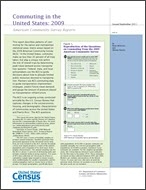Commuting in the United States: 2009
Commuting in the United States: 2009
This report describes patterns of commuting for the nation and metropolitan statistical areas (metro areas) based on the 2009 American Community Survey (ACS).1 In the United States, commutes make up less than 20 percent of all trips taken, but play a unique role within the mix of overall trips by determining peak travel demand across transportation systems.2 Federal, state, and local policymakers use the ACS to guide decisions about how to allocate limited public resources devoted to transportation. Planners use ACS commuting data to guide transportation improvement strategies, predict future travel demand, and gauge the amount of pressure placed on transportation infrastructure.
The ACS is an ongoing survey conducted annually by the U.S. Census Bureau that captures changes in the socioeconomic, housing, and demographic characteristics of communities across the United States and Puerto Rico.3 The ACS questions related to travel focus solely on commuting and do not ask about leisure travel or other nonwork trips. This report discusses commuting characteristics for workers 16 years and over who were employed during the week prior to the ACS reference week and did not work at home.
Respondents answer questions about where they work, what time they leave home for work, the means of transportation used to get there, the number of workers riding in a car, truck, or van, and how long it takes to travel to work. A reproduction of these questions can be found in Figure 1. The central topics of each section of this report are based on these commuting questions.
For each commuting attribute, findings are presented at the national and metro area levels for a variety of population characteristics such as sex, race, ethnicity, and workplace location.4 A set of more detailed tables associated with each commuting attribute is available for download through links provided throughout the report.
Commuting highlights from the 2009 ACS are:
- Over three-quarters of the nation’s workers drove alone to work.
- Workers took an average of 25.1 minutes to get to work.
- Hispanic workers carpooled at a rate of 16.4 percent, compared with 9.5 percent for non-Hispanic workers.
- The rate of public transportation usage among the foreign-born population was 10.8 percent, more than twice that of the native-born population, at 4.1 percent.
- Suburban workers drove alone at a rate of 81.5 percent, compared with 72.1 percent for workers living inside of a principal city.
- The New York-Northern New Jersey-Long Island, NY-NJ-PA Metro Area had the longest average commute, at 34.6 minutes.
- The 10 metro areas with the shortest average commute times have populations of fewer than 300,000 people.
As communities change, the information collected in the ACS provides timely and relevant data upon which transportation planning decisions may be made. A major advantage of the ACS is its rich array of sociodemographic information. The ability to link information about commuting to sociodemographic characteristics and geography allows planners to forecast local peak travel demand and address unmet transportation needs more accurately.
__________
1 This report discusses data for the United States, including the 50 states and the District of Columbia, but not the Commonwealth of Puerto Rico. For more information on metropolitan statistical areas, please see <www.whitehouse.gov/omb/assets/omb/bulletins/fy2009/09-01.pdf>.
2 Summary of Travel Trends: 2009 National Household Travel Survey. 2011. Technical Report No. FHWA-PL-11-022. <nhts.ornl.gov/publications.shtml>.
3 The ACS uses a series of monthly samples to produce annual estimates. Detailed questions that previously appeared on the decennial census long form are now included in the ACS, and the decennial census now simply produces a count of the nation’s population and a snapshot of its most basic demographic characteristics. The annual sampling rate for the ACS is about 2.5 percent of all housing units and includes residents living in group quarters. Five years of ACS data collection are necessary to achieve a cumulative sample large enough to ensure respondent confidentiality for smaller communities and for small geographies such as census tracts or block groups. For larger geographies, specifically those with populations of 65,000 or greater, estimates are available annually. For selected geographies with populations of 20,000 or greater, combined 3-year estimates are available. For the smallest geographic areas, the Census Bureau released 5-year estimates for the first time in December 2010. These estimates are based on data collected between 2005 and 2009. Workers are civilians and members of the Armed Forces, 16 years and over, who were at work the previous week. Persons on vacation or not at work the prior week are not included.
4 The estimates in this report (which may be shown in text, figures, and tables) are based on responses from a sample of the population and may differ from actual values because of sampling variability or other factors. As a result, apparent differences between the estimates for two or more groups may not be statistically significant. All comparative statements have undergone statistical testing and are significant at the 90 percent confidence level unless otherwise noted.
Tables
Additional File Formats
Additional file formats can be accessed in our archives.
Others in Series
Publication
Publication
Publication








